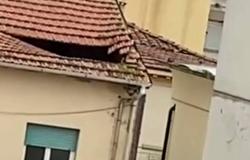PESCARA. Not just the Pescara-Rome fast line. The commercial plan of Rete Ferroviaria Italia includes a total of nine major works which also affect the coast and the internal area of L’Aquila and Sulmona. In a 734-page dossier, revised in November, RFI, a company of the FS Group, illustrates in detail the guidelines of the program of interventions to be implemented between 2023 and 2027 across the entire national territory. And from page sixty he talks about Abruzzo, outlining the picture of the new railway infrastructures which, for now to a small extent, are already taking their first steps.
In the following journalistic report we publish verbatim the nine passages of the dossier that concern us.
1)ROME-PESCARA
The strengthening of the Rome-Pescara railway connection is divided into various interventions. Scafa-Manoppello: doubling mainly in a variant of around 7 km, with a maximum speed of 180 km/h; Manoppello-Interporto: doubling on site for approximately 5 km, with maximum speed of 180 km/h. Subsequently we will proceed with the Sulmona-Pratola Peligna: doubling on the corrected road for approximately 5 km, with a maximum speed of 180 km/h; Tagliacozzo-Avezzano: doubling on site for approximately 15 km for a speed of 200 km/h.
To complete the project, the following interventions are also planned: doubling of the Avezzano-Sulmona and Pratola Peligna-Scafa sections; new Rome (Corcolle)-Tagliacozzo fast line. Another investment project is also expected to double the Pescara-Chieti-Interporto section and the new track connecting Pescara Centrale and Pescara Porta Nuova.
The benefits: reduction in travel times: Rome-Pescara in approximately 2 hours compared to the current 3h 20′, with a shorter travel time of up to 80′ upon completion of the entire project; capacity increase: from 4 to 10 trains/h on the routes subject to doubling, with the possibility of establishing metropolitan-type services between Chieti and Pescara; speeding up connections between Pescara and L’Aquila, thanks also to other ongoing and planned interventions on the L’Aquila-Sulmona line (Sulmona link road, new Sulmona S. Rufina stop).
2)DOUBLE DOUBLE PESCARA – CHIETI
ABRUZZO INTERPORT
The entire doubling project, 14 km long, of which 1.7 km is a variant, is a constituent part of the upgrading project of the entire Pescara – Rome line. The work was divided into five lots.
Lot 0: preparatory works for the new track connecting Pescara Centrale-Pescara Porta Nuova.
Lot 1: Pescara Porta Nuova-San Giovanni Teatino doubling, with route adjustments and consequent speeding up; the adaptation of the Pescara San Marco stops to TPL standards; construction of new Pescara Airport stop with sidewalks; the elimination of the level crossing in Corso Italia in San Giovanni Teatino.
Lot 2: doubling of San Giovanni Teatino-Chieti and adaptation of the Chieti Madonna delle Piane stop to TPL standards.
Lot 3: doubling of the Chieti-Interporto d’Abruzzo section. The objectives that the intervention allows to achieve are: metropolitan-type service between Pescara and Chieti (serving the university and airport) and recovery of travel times.
3)NEW TRACK
BETWEEN CENTRAL PESCARA
AND PESCARA PORTA NUOVA
The investment concerns the construction of a new connection, of approximately 1 km, between the Pescara Centrale station and the Pescara Porta Nuova station, aimed at making the Pescara-Sulmona/L’Aquila connections independent from the insistent traffic along the Adriatic line , with significant impacts on the two stations.
The project involves interventions on armament, electric traction and safety and signaling systems on the site built as part of the Pescara-Interporto d’Abruzzo doubling (Lot 0).
4)SULMONA BRACE
The intervention consists in the restoration of a pre-existing link road, of approximately 700 metres, and is aimed at speeding up railway connections on the Pescara-Sulmona-L’Aquila relationship and at avoiding technical delays due to the reversal of the trains in station.
The project also involves the construction of a new stop for passenger services on the slip road, called Sulmona Santa Rufina. The benefits: the current travel time on the Pescara-L’Aquila route is 2 hours. The goal of the surgery is to recover up to 10′.
5)STRENGTHENING OF
GUIDONIA-SULMONA LINE
The project involves technological upgrading interventions of line and station systems; in particular, the section will be included in the new traffic command and control system, with management from the Rome Termini central post; Furthermore, the technological upgrade of the train spacing system and interventions on the station master plans will be carried out aimed at speeding up the crossing systems, with the possibility of simultaneous movements, underpasses, simplifications, upgrading of station platforms and renewal of information devices at the public.
The technological upgrading interventions between Marcellina and Roviano have been completed; the interventions between Carsoli and Avezzano will be completed. A further phase will then be planned to complete the section up to Sulmona. The benefits: for Regional trains, average recovery of 1.4 minutes.
6)LINE ENHANCEMENT
TERNI – RIETI – L’AQUILA
The Terni-Rieti-L’Aquila-Sulmona route crosses the regions of Umbria, Lazio and Abruzzo and has a linear development of approximately 163 km. Due to the orography of the places crossed, it is tortuous, with little levels characterized by high ascent values and reduced curvature radii. This determines limitations regarding the maximum travel speed of the line.
The project envisages the following interventions for the Terni-Rieti section: adjustments to the route between Marmore and Rieti to raise the speed from 75 km/h to 100 km/h; modifications to the general regulatory plans of the Rieti, Stroncone, Contigliano, Greccio and Marmore plants with speeding up of the station itineraries to 60 km/h, with simultaneous movements, construction of underpasses/overpasses, adaptation of the sidewalks; adaptation of the peripheral posts of the Accm (simultaneous control system of multiple systems, ed) in the Terni-Rieti section; suppression of some level crossings.
The national program also includes the implementation of the Accm system on the Terni – Sulmona line. The benefits: speeding up of line sections, speeding up of station itineraries at 60 km/h, simultaneous movements.
7)ROUTE SPEEDING
PESCARA-TERMOLI-FOGGIA
For the Pescara-Termoli-Foggia section, the speeding up consists of minimal adjustments to the route and tunnels, local elevations, adaptation of railway infrastructure and works of art, technological upgrading of some systems, new distancing system, adaptation of stations and pavements.
These interventions will lead to a reduction of 35 minutes in travel times between Bologna and Lecce for long-distance services. In detail, for the Pescara-Termoli-Foggia route travel times are estimated at 10 minutes. The technological upgrading on the Pescara-Termoli route involves the activation in functional phases of the following routes: Francavilla-Ortona; Ortona-Port of Vasto; Port of Vasto-Termoli and Pescara Porta Nuova – Francavilla.
8)DOUBLE LINE
NORTH OF ORTONA
The work involves the doubling of the single track section in Ortona station (Pescara side), and the adaptation of the Castello tunnel. The current single track section runs in the Frentani tunnel while the intervention will be carried out in the Castello tunnel. Both will respectively constitute the even and odd running platforms of the Ortona station. The benefits: elimination of a 3-5 minute waste of time to allow trains approaching the single track section at the same time to cross.
9)NEW CONNECTION
WITH THE PORT OF VASTO
The intervention involves: the connection between the Port of Vasto and the RFI station, serving the industrial areas of Piana Sant’Angelo and Val di Sangro, through a stretch of non-electrified track directly on the port quay alongside the current headquarters via Punta Penna road; the construction of two tracks, one with a maneuvering rod function and the other with a goods loading/unloading function, both with a length of 250 metres; the construction of two new tracks in the Porto di Vasto station to replace the existing ones, currently out of operation, with a module of 575 metres. The intervention will offer the possibility of enhancing multimodal transport with direct ship-train passage on the quay and improving accessibility to the port.
©ALL RIGHTS RESERVED
For Latest Updates Follow us on Google News




